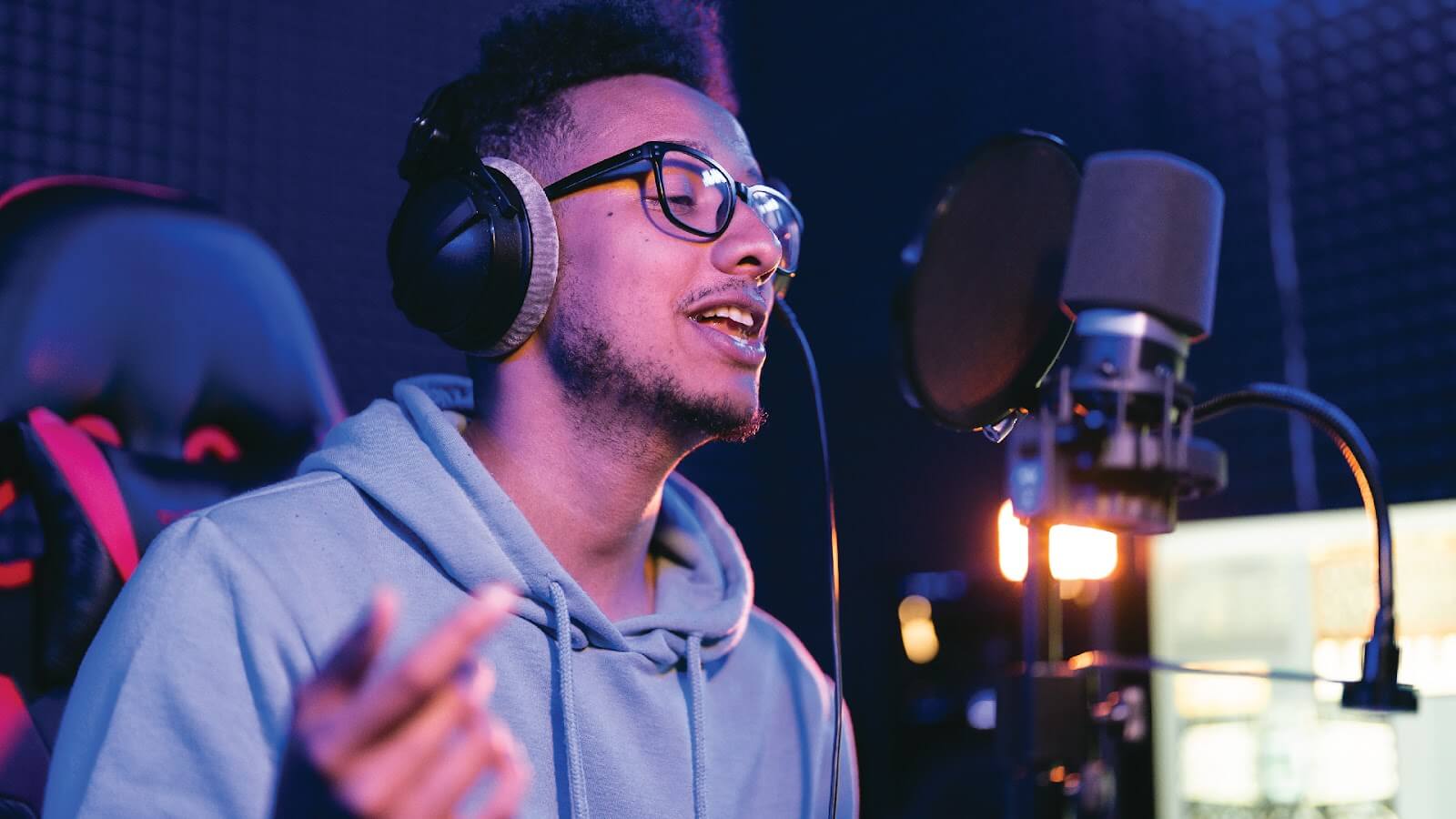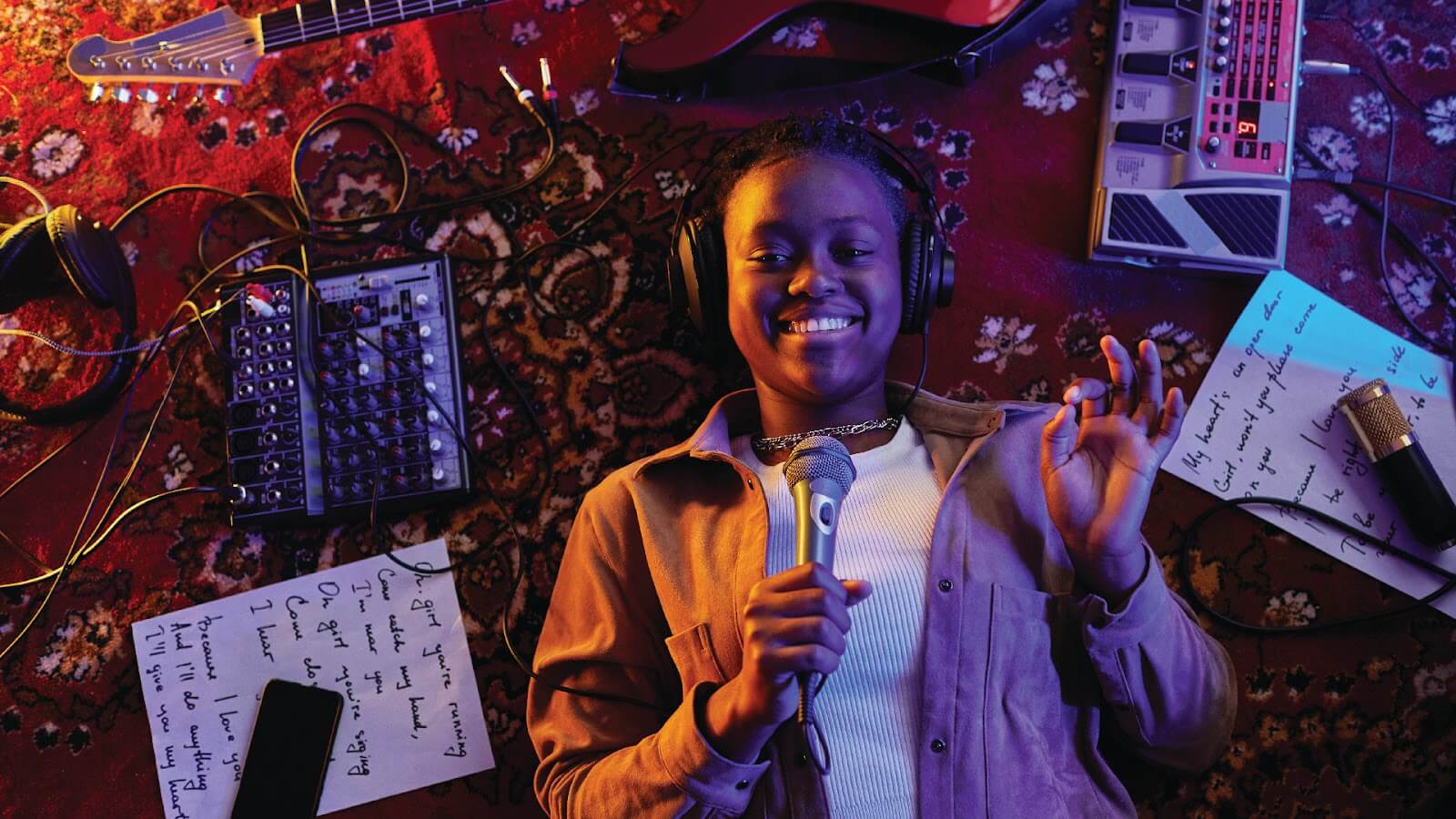Table of Contents
What really makes a rap song really great? Sure, the lyrics matter — even the greatest rapper needs something important to say — but that’s just one small part of a more complex equation. What really makes a verse stick in your head is how it flows. It’s the rhythm, the cadence, the way the words ride the beat and keep you hooked.
In this guide, we’ll discuss how to write a rap song for beginners, as well as offer expert tips for the more seasoned rappers out there looking for pointers. You’ll learn the basics of how to compose a rap that not only sounds good but also feels right. We’ll dive into essentials like flow, cadence, rhythm, and everything you need to take your rap game to the next level.
The Basic Elements of a Good Rap Song
Before we dive into how to make a good rap song, let’s look at the building blocks of a strong rap song:
Beat
The beat is the backbone of any rap song. It’s what gives the track its vibe and direction. Whether it’s chill, hype, or anything in between, the beat sets the tone for everything else. You don’t need to overthink it — just find or create a beat that feels right and matches the energy you’re going for. Once you’ve got the beat locked in, it becomes the anchor for your verses.
Story
A good rap song isn’t just random bars thrown together — it has a story or a theme. This doesn’t mean you need to craft a full narrative, but your lyrics should have a purpose and something that gives the song meaning. Your options here are endless! It can be personal, social, or good old-fashioned fun. Just remember that the story is what connects the artist to the listener, so it needs to resonate.
Flow
We couldn’t talk about how to make a rap song without talking about flow. Flow is all about how your words sync with the beat. It’s your rhythm, how you pace your bars, and how smooth everything sounds when it comes together. A strong flow keeps the listener on their toes and makes your track feel effortless. So, play around with different rhythms, but make sure your flow fits naturally with the beat. When it all comes together, that’s when your song really starts to take shape.
Lyrics
At its core, your lyrics are the message you’re delivering. While writing rap lyrics, don’t fall into the rhyming trap. Yes, it’s nice when the words rhyme, but that’s not the most important part. Focus on saying something real and meaningful. The best lyrics are those that connect with people, whether through clever wordplay, deep emotion, or a message that sticks. Rhyming is just the icing on the cake — it’s the substance behind the words that counts.
How Do I Write a Rap Song?
So, how do you put these four elements together to create something special? When it comes to how to construct a rap song, the first thing you need to keep in mind is that your first great rap probably won’t happen overnight. Making a great track means you’ll need to master a few key components and usually takes time and practice.
While the process will vary from person to person, here’s how to make a rap song in 10 steps:
1. Create Your Flow
Flow is the rhythm and timing of your lyrics as they interact with the beat. It’s what gives your verse that natural bounce or roll. Flow can vary a lot between rappers, and that’s what makes it so personal. Kendrick Lamar, for example, is known for shifting flows mid-song, jumping from rapid-fire bars to more spaced-out rhythms.
To develop your flow, start by paying attention to the beats you’re working with. Count the beats in each bar and experiment with placing your words in different spots. Try rapping your lyrics over a beat in multiple ways, speeding up or slowing down certain sections. The more you practice, the more you’ll develop an ear for what feels right.
2. Choose the Right Beat
The beat is what sets the stage for your entire track. This means that your choice of beat can either complement your flow and lyrics or clash with them, so it’s important to get it right. For example, if you’re someone who prefers a slower, more relaxed delivery, a lo-fi beat might suit you. On the other hand, if you’re looking for high energy, a hyphy beat with fast hi-hats might be exactly what you’re looking for.
When choosing a beat, think about the mood you want to create. Is it introspective and chill, or upbeat and energetic? You can find beats online through platforms like YouTube, BeatStars, or even SoundCloud. Listen to different options, and don’t rush it — when you find the right one, you’ll know it.
3. Develop Your Cadence
You’ve probably heard this term before in discussions about popular rappers — and for good reason. Cadence refers to the rhythm, pitch, and overall delivery of your voice as you rap. It’s incredibly important because it can change the entire feeling of a verse, even if the words stay the same. Think of J. Cole, who uses cadence to quickly switch from a calm tone to something more intense, depending on the subject. Lil Wayne, on the other hand, often uses pitch changes and rhythm shifts to make his bars pop with personality.
A great way to train your cadence is to try saying the same line with different vocal inflections. Play with your pitch, pace, and even how much force you put behind your words. Recording yourself and listening back can help you identify which cadences feel right for different beats. And don’t be afraid to experiment — your cadence is what makes your delivery unique and keeps things interesting.
4. Explore Syncopation and Rhythmic Variation
Want to learn how to make rap music that keeps your audience on their toes? Try syncopation, which is when you intentionally shift the rhythm of your lyrics off the main beat to create a more unpredictable and complex flow. It adds an element of surprise and keeps the audience engaged, as the unexpected shifts in rhythm can make even simple lines feel more dynamic.
Explore syncopation by rapping your lines on the beat and then shifting certain words or syllables slightly ahead or behind the beat. Practice by freestyling over a beat and intentionally shifting your emphasis to see what feels natural yet unexpected.
5. Find the Pocket
Finding the pocket when you’re trying to figure out how to write a rap song means aligning your lyrics with the beat in a way that feels effortless and smooth. When you’re in the pocket, your flow fits perfectly within the rhythm of the track, making it sound like the lyrics and beat were made for each other. Artists like Jay-Z are masters at this, gliding through verses without ever feeling rushed or off-tempo.
To find the pocket, try rapping over different beats and tempos until you find a rhythm that feels just right. You can even practice with a metronome or even just tapping out the beat with your foot to help you lock in.
6. Vary Your Flow
One of the biggest mistakes new rappers make is sticking to the same flow throughout the entire song. Variety and switch-ups are the name of the game when it comes to catchy rap. Eminem and Drake are great examples of artists who change their flow multiple times in a single song, sometimes going from rapping to singing in the same bar. This makes each section of the track feel fresh and prevents it from becoming repetitive.
So, experiment with speeding up or slowing down your delivery or switching up your rhyme schemes. You don’t need to reinvent the wheel each time — small changes can go a long way in keeping your track dynamic and interesting.
7. Use Pauses and Silence Effectively
Want an overlooked secret for how to construct a rap song like the pros? Take a breath — literally. In any genre of music, pauses and silences can be just as powerful as the words themselves, creating suspense, highlighting a punchline, or giving the listener a moment to reflect on what you’ve just said. The greats, like Kendrick Lamar and Kanye West, are known for using pauses for dramatic effect, letting certain lines linger before the beat kicks back in.
Do this by thinking about where your verses need a moment to breathe. It could be right before an important line or after a particularly heavy bar. Practice rapping with pauses and notice how they can shift the energy of your verse. Silence can create tension and make your next line hit even harder.
8. Structure Your Verses
A well-structured rap song keeps the listener engaged from start to finish. Typically, a rap track consists of verses, hooks, and sometimes bridges, and how you organize these elements can make or break the song’s flow. Keep in mind that you don’t have to stick to a rigid structure. In fact, songs that play around with different structures are often some of the best.
When structuring your verses, consider how you want to build momentum. Start strong, but don’t give everything away in the first few bars — let your verse build toward a peak with things like a clever punchline, a shift in flow, or a powerful message. Vary your cadence and flow within different sections of the song to keep things unpredictable.
9. Match Your Cadence to the Beat
Cadence and beat are like dance partners — they need to move together. So, matching your cadence to the beat means adjusting the rhythm and tone of your voice to fit the energy and pace of the track. Rappers like Travis Scott are pros at syncing their cadence with the beat, making their verses feel like a natural part of the music rather than something layered on top.
Practice this by rapping the same lyrics over different beats and notice how the feel of your delivery changes. A slow beat might call for a laid-back cadence, while a fast-paced beat could require something quicker and more aggressive. The goal is to find the balance where your voice and the beat feel like they’re in perfect harmony.
10. Practice and Experiment
The key when learning how to compose a rap and develop a distinct style is constant practice and experimentation. Don’t be afraid to try new things! Switch up your beats, flows, cadences, and even your recording environment. Record yourself often and listen back to see where you can improve. Most of the greatest rappers didn’t find their sound overnight — it took years of trying out different techniques until something clicked.
Experiment with different beats from various genres and don’t shy away from taking risks. Remember: great rap music evolves, so keep pushing yourself to grow and evolve with it.
Tips for Composing a Powerful Rap Song
Now that you know the steps for how to make a good rap, keep the following tips in mind during your next session:
- Find Inspiration Everywhere: Keep your ears and eyes open. Inspiration can come from everyday life, conversations, or even other forms of music. Don’t limit yourself to traditional topics — draw from anything that resonates with you.
- Experiment with Different Flows: Don’t be afraid to try new rhythms and flows. The best rappers stand out because they bring something fresh to the table. Practice different patterns and see what feels natural to you.
- Stay Consistent: Writing and rapping require constant upkeep, so make it a habit to write every day, even if it’s just a few bars.
- Get Feedback: This may be the most important tip on this list. Share your work with trusted friends, fellow artists, or even online communities. Getting constructive criticism can help you see your work from different angles and improve.
- Break Traditional Structures: Don’t feel tied to the standard verse-chorus-verse format. Experiment with different structures, like starting with the hook or switching between short and long verses.
- Study the Greats: Learn from the best by studying interviews, breakdowns, and analysis of top rappers. Books like The Book of Rhymes: The Poetics of Hip Hop by Adam Bradley or podcasts like Dissect offer deep dives into the thought process behind some of rap’s most iconic songs.
- Explore Advanced Techniques: Once you’ve got the basics down, start exploring more complex songwriting techniques like double entendres, internal rhymes, and metaphors. There are books, YouTube channels, and online courses dedicated to teaching these advanced skills.
- Stay Open to Growth: Keep learning, experimenting, and listening to new music to stay sharp and grow as an artist.
Learn from the Experts at Cadomu Music Academy
Whether you're a complete beginner or have dabbled in writing before, our Rap 101 class will give you the confidence and tools to bring your ideas to life.
Our experienced instructors will guide you through the essential skills you need, from developing your flow to choosing the perfect beat. Deepen your skills with personalized feedback, comprehensive resources, and community engagement with fellow writers and songwriting experts.
At Cadomu Music Academy, our mission is to help artists unlock their creative potential and push their skills to new levels. We believe that music is deeply personal, and we’re here to help you express yourself in a way that feels authentic and true to you.
Our songwriting classes blend music tradition with the latest technology, offering a hands-on approach led by experienced educators. Have questions? Check out our FAQ page or contact us to learn more!




